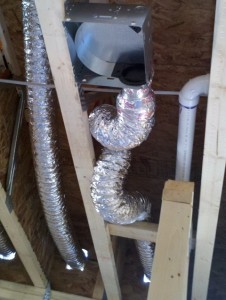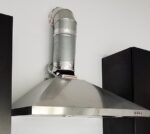 In last weeks Monday Musings on the Great Ventilation Debate part Deux we dived into what is possibly coming down the pike for 2022 with two standards on ventilation in this “COVID” age, namely 62.1 & 62.2. Unfortunately, the article was getting to long so we had to leave off; hey what about all the other contaminant’s, what would we or others like to see / should be in there, and just how can one makes things simpler. In many ways, all three of these tie together, so we will comingle many of these items together. I must state I am mainly going to focus on the Residential arena as many items I am covering are already in the commercial version.
In last weeks Monday Musings on the Great Ventilation Debate part Deux we dived into what is possibly coming down the pike for 2022 with two standards on ventilation in this “COVID” age, namely 62.1 & 62.2. Unfortunately, the article was getting to long so we had to leave off; hey what about all the other contaminant’s, what would we or others like to see / should be in there, and just how can one makes things simpler. In many ways, all three of these tie together, so we will comingle many of these items together. I must state I am mainly going to focus on the Residential arena as many items I am covering are already in the commercial version.
Quick Definitions:
Standard 62.1-2019 (Commercial / Industrial) and Standard 62.2-2019 (Residential) per ASHRAE are “the recognized standards for ventilation system design and acceptable IAQ”. First published in 1973 as Standard 62, it was then broken apart into two separate standards back in 2003 and they specify the minimum ventilation rates for both new and existing buildings along with other acceptable measures. These are intended to provide indoor air quality that is acceptable to human occupants and to help minimize adverse health effects.
Ventilation: There are 3 general principles related to ventilation which involves replacing indoor air with outdoor (aka “fresh”) air; exhaust, dilution, & intake. This ventilation can be handled via mechanical means or natural means (i.e. opening a window – though the codes hardly recognize that as an option.)
Appliance Equipment Standard: Based on the Energy Policy and Conservation Act (EPCA) of 1975, this legislation created a “Federal” minimum for appliance efficiency thus blocking many states from enacting their own thus eliminating a potential patchwork of standards for manufacturers to have to deal with. California is actually exempt due to a 1974 act and it was the first state to actually create standards & continuously upgrades them (with many of them getting adopted federally).
Increase Ventilation?
Commercial codes are interesting as the ventilation requirements are based on what the space is designed for. A nail salon requires a lot more than say a warehouse or an office. They also allow some ventilation to be offset due to Filtration & be controlled via monitoring. Residential is pretty much a flat you will have X. As mentioned in our last piece they still haven’t done studies on how much is needed & any changes are flat out arbitrary. Many of us believe this is to much for most homes & can’t see a reason to increase them (yes even with Covid). This especially gets to be even more true when you consider that many large houses rarely come close to the occupancy listed.
With that said I have no issues with them raising the bar some, but, with some major caveats. The first is to eliminate all the weird equations like “natural air leakage” based off blower door numbers. The second is eliminate the Square Footage Calculation – Base is 2 people for 0 to 1 bedrooms & then one additional person for each additional bedroom. Lets call it 20 CFM per person & we can say continuous also. Now for “non-continuous” use which many of us encourage (I personally size to meet need & then start up at 25 to 50% based on occupants & adjust up as needed / customer desires) we will bump it up to 30 CFM but that is to be based off of monitoring only – Carbon Dioxide, VOC’s like formaldehyde, NOXs, & even yes, humidity.
I would say that a monitor should be placed in the “great room” area & also another in the bedroom(s) – as these are the two main living places where people congregate. While we are at it, one should also allow for ramped up usage – say Carbon Dioxide is tripped lets say at 600, it should start off on low & if it hits say 800 it should ramp up to medium or maybe even full.
What about Filtration?
It should not be in there: While it does play a factor, it is not a constant for most places – you have the shoulder seasons where the AC or furnace is more than likely not going to turn on for days at a time (shoot I know of some places where they say there AC only runs for maybe 10 hours total in the summer). If the unit is running, then it will help with the “monitored” option above as it will help dilute or maybe even eliminate some of those monitored items out of the air thus cutting down on ventilation required.
As for continuous use types – I don’t see a “simple” way to say hey you can cut down so much for all types… But commercial does right – well yes but those units are basically running 24×7 or at least as long as someone is in the building, whereas residential doesn’t though Nate Adams does have a system based on a similar principle. Maybe for Nate’s or units with a dedicated ERV or HRV with a filter I could possibly see one saying you can drop 20 CFM of the required air flow?
Get serious about Exhaust:
 Seriously 20 continuous or 50 intermittent for bathroom exhaust & kitchens are 25 / 100? Then of course these numbers aren’t even tested so you are lucky to 80% of the rated flow? This is ridiculous.
Seriously 20 continuous or 50 intermittent for bathroom exhaust & kitchens are 25 / 100? Then of course these numbers aren’t even tested so you are lucky to 80% of the rated flow? This is ridiculous.
Bathroom Exhaust:
As pointed out in “Getting the Details Right: Bathroom Exhaust Venting” a 6×8 bathroom with 8′ walls needs 60 CFM of exhaust & if it has a steam shower it should be at 80 CFM. Yes that should also be tested & yes all bathrooms should have an exhaust as the window exception is a joke as very few really use it. Still want to leave the window exemption in – fine add another 30 or 40 CFM to the ventilation requirement for each bathroom without an exhaust fan.
Kitchen Exhaust – Electric / Induction:
 Yes, I am going to break things up based on cooking method which I will get to in the “gas” section. For all units a 25 CFM continuous fan is a joke & a 100 CFM fan isn’t that far off unless you are just boiling water. Let’s use a legitimate size as discussed in “Getting the Details Right: Kitchen Exhaust Venting” which starts around 200 CFM for small ranges using most available metrics. Shoot I would even say make it a flat 200 CFM exhaust hood being mandatory for all ranges – 250 CFM for kitchen islands. There is a ton that could still be added like proper sizing of the hood & height but shoot lets at least get a proper size listed first.
Yes, I am going to break things up based on cooking method which I will get to in the “gas” section. For all units a 25 CFM continuous fan is a joke & a 100 CFM fan isn’t that far off unless you are just boiling water. Let’s use a legitimate size as discussed in “Getting the Details Right: Kitchen Exhaust Venting” which starts around 200 CFM for small ranges using most available metrics. Shoot I would even say make it a flat 200 CFM exhaust hood being mandatory for all ranges – 250 CFM for kitchen islands. There is a ton that could still be added like proper sizing of the hood & height but shoot lets at least get a proper size listed first.
Kitchen Exhaust – Natural Gas / Propane:
Why separate this from electric & induction units? Well, there have been quite a few comments & discussions out there based on the additional pollutants cooking with gas adds & hey, they should be accounted for additionally. Personally a properly sized & placed hood handles that along with the other cooking pollutants but why spoil a great argument with facts. So with said, fine require 250 CFM for standard ranges & 300 CFM for islands.
Hoods not mandatory & recirculating hoods?
Plain & simple – any place that has a cooktop or is setup for one needs a hood & just like bathrooms it should exhaust directly outdoors. Oh boy, the Passive House (PHIUS) people are going to have a stroke – hey we like using recirculating hoods & pipe in an exhaust from our kitchen through our $5000 ERV/HRV/Magic Box. First repeat after me (unless you are building PHIUS) I will never exhaust from my kitchen or bathroom through an ERV which can not only clog the filter but recirculate the air back into the house. I also understand that per mechanical codes a “return” duct is not allowed in bathrooms or within 10′ of the stove.
So how about those crazy PHIUS folks or ones that don’t want an exhaust hood – no problem just add another 150 to 200 CFM of ventilation to the requirement. Problem solved
Electrify This:
Gas is evil – it should be banned aka Electrify Everything… In reality we have covered why this is mostly incorrect & they have suffered a few set backs. For example the mandatory, you shall install circuits for going electric has been overturned – partly due to preemption issues but also because it went past the scope of what the IECC & IRC are designed to do. The only way they have a chance is the NFPA aka the Electric Code. With that they do bring up some good issues which should be addressed in 62.2. One of these I hit above on the kitchen ventilation.
Natural Draft Equipment:
I love hear people talking about NO2 & CO2 as they seemingly blame it all on gas ranges. In reality most issues (i.e. where inside values are higher than outside) can be traced back to naturally drafted appliances (Water Heater / Furnace). Let’s be blunt – there is no reason for natural drafted appliances to be inside the homes conditioned envelope much less draw air from it. Preemption – not an issue as you are not mandating equipment specs but what is allowed in a space. Oh & guess what it is in the codes (though some like Illinois strike the provision) which reads:
IECC 2018 R402.4.4: Rooms containing fuel-burning appliances. In Climate Zones 3 through 8, where open combustion air ducts provide combustion air to open combustion fuel burning appliances, the appliances and combustion air opening shall be located outside the building thermal envelope or enclosed in a room that is isolated from inside the thermal envelope…
So yes, it should be addressed in the standard which would also help streamline / simplify some of the language in there. Oh & yes I will also state power drafted appliances should also be added.
Pilot Lights a No-No?:
Sorry, but you will lose due to preemption – if you want to limit pilot lights you will have to go through DOE. Personally I don’t think a furnace should have a standing pilot light as you need electricity to run the blower motor, etc… Gas ranges – I can’t think of any new ones that have them anymore, though maybe some commercial ones do? Water Heaters – most have electric ignition but some still have pilot lights & given a chance I would buy one of those especially if I lived in a more rural area.
With that having lived for three weeks without electricity due to tornados & being a big fan of resilient building / shelter in place, I have an issue with banning them all together. Fortunately my water heater at the time (yes it was direct vent) did have a pilot light so I got to enjoy a hot shower when needed. Granted I could light the range with a lighter but that isn’t the safest thing to do but you got to do, what you got to do. Shoot maybe we need battery backup / powered igniters on water heaters & ranges if we do want to ban them? As for water heaters, also just remember that a pilot light isn’t over heating the water & basically just keeping at temperature instead of requiring it to kick on full blast every so often to replace lost heat through the insulation.
Ventless Fireplaces:
For the love of god, can these ventless fireplaces finally be banned to outside use only – yes this sidesteps preemption as listed above. The amount of moisture they dump (assuming it is working properly) is astronomical & has caused so many issues it is ridiculous because who really leaves a window open when they are running?
In Closing:
I think that covered most of the topics (except for make up air which probably also should be addressed for those with Exhaust Only & Balanced Systems) I think many would like to see addressed in the next go around. I also think this would also cut down on a ton of confusing verbiage, wacky sizing, and shoot even the size of the standard. As for designing & installing things so you do have great ventilation, well that varies by building, layout, & what people want – I don’t see any easy way to address that via a standard. But accomplishing the above would be a good start. With that we would love your .02 – you think we are close to the mark, miss something, or… If so please leave a comment below.
